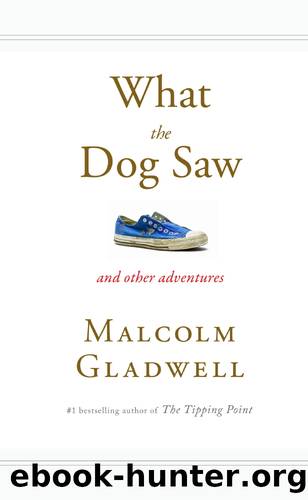What the Dog Saw by What The Dog Saw (epub)

Author:What The Dog Saw (epub)
Language: eng
Format: epub
Publisher: Little, Brown and Company
Published: 2009-10-20T00:00:00+00:00
3.
Dershaw picked up a new X-ray and put it on the light box. It belonged to a forty-eight-year-old woman. Mammograms indicate density in the breast: the denser the tissue is, the more the X-rays are absorbed, creating the variations in black and white that make up the picture. Fat hardly absorbs the beam at all, so it shows up as black. Breast tissue, particularly the thick breast tissue of younger women, shows up on an X-ray as shades of light gray or white. This womanâs breasts consisted of fat at the back of the breast and more dense, glandular tissue toward the front, so the X-ray was entirely black, with what looked like a large, white, dense cloud behind the nipple. Clearly visible, in the black, fatty portion of the left breast, was a white spot. âNow, that looks like a cancer, that little smudgy, irregular, infiltrative thing,â Dershaw said. âItâs about five millimeters across.â He looked at the X-ray for a moment. This was mammography at its best: a clear picture of a problem that needed to be fixed. Then he took a pen and pointed to the thick cloud just to the right of the tumor. The cloud and the tumor were exactly the same color. âThat cancer only shows up because itâs in the fatty part of the breast,â he said. âIf you take that cancer and put it in the dense part of the breast, youâd never see it, because the whiteness of the mass is the same as the whiteness of normal tissue. If the tumor was over there, it could be four times as big and we still wouldnât see it.â
Whatâs more, mammography is especially likely to miss the tumors that do the most harm. A team led by the research pathologist Peggy Porter analyzed 429 breast cancers that had been diagnosed over five years at the Group Health Cooperative of Puget Sound. Of those, 279 were picked up by mammography, and the bulk of them were detected very early, at what is called Stage One. (Cancer is classified into four stages, according to how far the tumor has spread from its original position.) Most of the tumors were small, less than two centimeters. Pathologists grade a tumorâs aggression according to such measures as the âmitotic countâ â the rate at which the cells are dividing â and the screen-detected tumors were graded âlowâ in almost 70 percent of the cases. These were the kinds of cancers that could probably be treated successfully. âMost tumors develop very, very slowly, and those tend to lay down calcium deposits â and what mammograms are doing is picking up those calcifications,â Leslie Laufman, a hematologist-oncologist in Ohio, who served on a recent National Institutes of Health breast-cancer advisory panel, said. âAlmost by definition, mammograms are picking up slow-growing tumors.â
A hundred and fifty cancers in Porterâs study, however, were missed by mammography. Some of these were tumors the mammogram couldnât see â that were, for instance, hiding in the dense part of the breast.
Download
This site does not store any files on its server. We only index and link to content provided by other sites. Please contact the content providers to delete copyright contents if any and email us, we'll remove relevant links or contents immediately.
Asking the Right Questions: A Guide to Critical Thinking by M. Neil Browne & Stuart M. Keeley(5705)
Autoboyography by Christina Lauren(5202)
Eat That Frog! by Brian Tracy(4479)
Dialogue by Robert McKee(4352)
Sticky Fingers by Joe Hagan(4142)
Journeys Out of the Body by Robert Monroe(3588)
Annapurna by Maurice Herzog(3445)
Full Circle by Michael Palin(3413)
Schaum's Quick Guide to Writing Great Short Stories by Margaret Lucke(3342)
Elements of Style 2017 by Richard De A'Morelli(3323)
The Art of Dramatic Writing: Its Basis in the Creative Interpretation of Human Motives by Egri Lajos(3035)
Atlas Obscura by Joshua Foer(2925)
Why I Write by George Orwell(2911)
The Diviners by Libba Bray(2905)
In Patagonia by Bruce Chatwin(2893)
The Fight by Norman Mailer(2883)
The Mental Game of Writing: How to Overcome Obstacles, Stay Creative and Productive, and Free Your Mind for Success by James Scott Bell(2873)
Venice by Jan Morris(2545)
The Elements of Style by William Strunk and E. B. White(2452)
